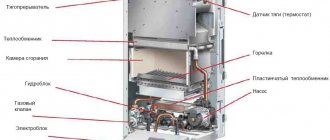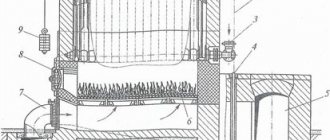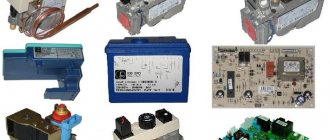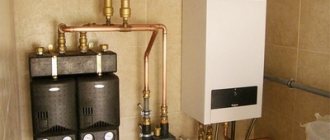The most effective way to heat your home is to install a gas boiler. A large number of models on the market can satisfy the needs of all categories of users. Choosing a gas boiler based on its technical parameters will help determine a product that will operate effectively for a long time without failures or extra costs.
Types and design of gas boilers
The device is an installation for creating thermal energy by burning fuel. A gas boiler is the most common type of heat generator, due to the cost-effectiveness of the substance and the reliability of the equipment.
Domestic and foreign industry produces a wide range of installations with very different characteristics.
Gas heating appliances are technological equipment that is made from durable materials. To ensure reliability, diagnostic sensors are provided, as well as a security system that blocks the operation of the boiler if a malfunction is detected.
According to design features, equipment can be divided into several groups.
For installation:
- floor;
- wall-mounted
By number of circuits:
- single-circuit;
- double-circuit.
By burner type:
- atmospheric;
- closed.
The main structural elements of the boiler are:
- gas burner - fuel releases energy in it;
- heat exchanger - energy heats circulating water;
- flue gas removal system;
- expansion tank - to compensate for fluctuations in coolant volume due to heating;
- complex with a self-diagnosis sensor;
- Control block.
In addition, many models use a circulation pump to pump coolant. Air supply and smoke removal are carried out by a fan.
Principle of operation
Regardless of the type, the functioning scheme of all boilers is the same.
The smooth operation of the equipment is carried out according to the following algorithm:
- The sensor system measures the temperature - if it is below the set value, the thermostat controller opens the gas valve. Fuel enters the combustion chamber.
- Next, the electric or piezo ignition is triggered.
- As a result of the combustion reaction, the water circulating in the heating circuit begins to heat up in the heat exchanger.
- Having reached the temperature set by the thermostat, the automation turns off the burner.
This is how a single-circuit boiler works. To provide the house with not only heating, but also hot water, in addition to such an installation, you can connect an electric boiler or gas water heater.
Double-circuit boilers are capable of not only raising the temperature in the room, but also heating water.
But such installations cannot work simultaneously to generate heat and supply hot water. For a small private house or apartment, stopping the heating circuit for a short time is almost imperceptible.
If we are talking about a room of considerable area, the best solution would be to install equipment for heating and hot water supply, operating independently of each other.
How do such devices work?
All wall-mounted gas boilers can be divided into two large groups - single-circuit and double-circuit. The former are used for the installation of autonomous heating systems, and the latter are purchased if, in addition to heating, it is necessary to provide hot water for technical needs.
All wall-mounted double-circuit boilers are designed quite simply. There are two circuits inside them. The first provides heating radiators with coolant, and the second plays the role of a water supply system. Moreover, the technical characteristics of some models allow the use of the secondary circuit in two operating modes. It can function together with the heating circuit and separately from it. This function is very convenient in the summer, when you need to use hot water without heating the house.
When studying the technical parameters of the device, you must also pay attention to the operating principle of the installation. Some manufacturers produce gas boilers that heat water only after the cold water supply tap is opened. Other manufacturers offer samples operating in boiler mode. In them, water is supplied to a separate tank, and only there is it heated to a certain temperature.
Note! Practice shows that the boiler mode is more economical, but only if there is a large tank available.
Specifications
Depending on the type of equipment, a different set of parameters is taken into account when selecting a model.
Wall-mounted devices are a ready-made heating system that is easy to install. They are economical, but sensitive to voltage changes in the electrical network. When installing a boiler in a private house, it is wise to install a good voltage stabilizer and an uninterruptible power supply.
When selecting a model for a wall-mounted unit, the most important technical characteristics are:
- installation power - selected based on the area of the room;
- efficiency - fuel consumption depends on the parameter; for most wall-mounted models this indicator changes slightly;
- noise - important when installing equipment in a residential area;
- heat exchanger material - most models are equipped with a copper or steel coil, some use aluminum, which is cheaper but has lower thermal conductivity and corrosion resistance;
- the presence of additional functions - different devices are equipped with their own list of capabilities;
- the material from which the internal parts of the boiler are made - plastic is used in cheap models, brass is used in expensive boilers.
Floor heating devices are difficult to install. Incorrect installation may cause service problems. However, this technique is insensitive to voltage surges, durable, and reliable.
For floor structure equipment, it is worth considering the following characteristics:
- power - it is recommended to take a boiler with a reserve, since in the cold season the indicator decreases;
- heat exchanger material - in stationary models steel or cast iron is used;
- Dimensions - floor units may differ in height and width;
- energy dependence - complex expensive devices are equipped with automation powered by electricity; simple devices do not require a network connection;
- Efficiency - the spread of this parameter for floor-standing installations varies over a wide range.
Technical data
Wall-mounted gas boilers are created on the basis of modern developments with an automated control system. A wall-mounted gas device for a closed-structure home is intended for small rooms with a perimeter of no more than 200 sq.m. The productivity of the unit is 30 kW. This type of heating equipment contains additional elements and fasteners to equip a more complex technological structure of pipe lines in the building.
Wall-mounted gas boiler
On the front side of the unit with the camera there are all the necessary buttons to start the system, as well as spare parts for repair work. To inspect the parts inside the boiler, you need to remove the front cover. The elimination of smoke emitted into the room is carried out using atmospheric draft produced by some types of boilers. The rest eliminate smoke thanks to a fan built inside. When choosing a ready-made model with a built-in ventilation system for your home, you will not need to build a chimney or lay additional ventilation ducts.
Double-circuit structure of closed boilers
The double-circuit structure of boilers of a closed design has several water intake sections. But when you open the second tap, you can notice a decrease in pressure in the pipeline over time, which leads to a drop in the temperature of the coolant. To avoid a difference in the pipes, preference should be given to models of a dual-circuit structure with a water storage chamber of 60 liters. Such models of home heating devices are equipped with a three-level mixer and a built-in boiler, which is able to maintain the temperature regardless of the amount of material consumed and the pressure in the pipeline.
What is the difference between a floor-standing gas boiler and a wall-mounted one?
In the first case, the units have medium or high power. They differ in greater mass. The power of such a device can exceed 300 kW. The installation is capable of effectively heating residential, domestic and commercial premises of considerable area.
The main design difference between a floor-mounted heating device and a wall-mounted one is the heat exchanger. In the first case, it is larger and more massive. Material: alloy steel or cast iron. The latter has increased fragility, but is resistant to corrosion, has high thermal conductivity, and is durable. At the same time, floor-standing devices can be either completely energy-independent or operate when connected to the mains.
Wall-mounted boilers are equipped with heat exchangers made of steel or copper. The service life of such installations is shorter. They are convenient to use for heating residential premises. They operate quietly, have small dimensions and weight. All wall-mounted units are energy-dependent. For the operation of the pump and fan, which ensure the movement of the coolant, as well as the removal of flue gases, a connection to the electrical network is required.
Advantages of using a condensing gas boiler
So, we have dealt with the theoretical part. Now we’ll tell you how the design features of a condensing boiler affect its operating efficiency and durability. At first glance, it seems that it is possible to use the additional energy of water vapor hidden in the flue gases in a conventional boiler, specially “driving” it into a low-temperature operating mode. For example, by connecting the boiler (this is incorrect) directly to the underfloor heating system or by significantly lowering the temperature of the coolant circulating in the radiator heating system. But, we already wrote above that during the combustion of main gas a whole “bouquet” of chemical elements is formed. Water vapor contains: carbon dioxide and carbon monoxide, nitrogen oxides, and sulfur impurities. During condensation and the transition of steam from a gaseous to a liquid state, these impurities end up in water (condensate) and the output is a weak acidic solution.
Sergey Bugaev
The heat exchanger of a conventional boiler will not withstand prolonged operation in an aggressive chemical environment; over time it will rust and fail. The condensing boiler heat exchanger is made of materials that are corrosion resistant and resistant to acidic environments. The most resistant material is stainless steel.
In the manufacture of the condensing boiler, only durable and wear-resistant materials are used. This increases the service life and reliability of this equipment, and also reduces maintenance costs.
In addition, increased requirements are placed on other structural elements of the condensing heat generator, because it is necessary to cool the flue gases to the required temperature. For this purpose, the boiler is equipped with a forced-air burner with a high degree of modulation. This burner operates over a wide power range, which allows you to optimally regulate water heating. Condensing boilers are also equipped with automatic equipment that ensures precise maintenance of the combustion mode, temperature of the exhaust gases and water in the return line. Why are circulation pumps installed that smoothly change the pressure force of the coolant flow, and not as simple 2- and 3-speed pumps? With a conventional pump, the coolant flows through the boiler at a constant speed. This leads to an increase in the temperature in the “return”, an increase in the temperature of the flue gases above the dew point, and, consequently, a decrease in the efficiency of the equipment. It is also possible for the heating system (warm floor) to overheat and reduce thermal comfort.
Important nuance : the burner of a conventional boiler cannot operate at a power below 1/3 of the maximum (rated) power of the heat generator. The condensing boiler burner can operate at a power of 1/10 (10%) of the maximum (rated) power of the heat generator.
Sergey Bugaev
Consider the following situation: the heating season has begun, the temperature outside is -15 °C. The power of a conventional boiler installed in a house is 25 kW. The minimum power (1/3 of the maximum) at which it can operate is 7.5 kW. Let's assume that the building's heat loss is 15 kW. Those. The boiler, continuously operating, compensates for these heat losses, plus there remains a power reserve. A few days later there was a thaw, which, you see, often happens during the winter. As a result, the outside temperature is now around 0 °C or slightly lower. The heat loss of the building, due to the increase in outside temperature, has decreased and is now approximately 5 kW. What will happen in this case?
A conventional boiler will not be able, operating in continuous mode , to produce the 5 kW of power necessary to compensate for heat loss. As a result, it will go into the so-called cyclic mode of operation. Those. the burner will constantly turn on and off, or the heating system will overheat.
This mode is unfavorable for the operation of the equipment and leads to its accelerated wear.
A condensing boiler, with the same power and in a similar situation, in continuous operation will quietly produce 2.5 kW of power (10% of 25 kW)¸ which directly affects the service life of the heat generator and the level of comfort in a country house.
The condensing boiler, complemented by weather-dependent automation, flexibly adapts to changes in temperature throughout the heating season.
Modern automation makes it possible to significantly simplify the process of boiler control, including remotely, using a special mobile application for smartphones, which increases the ease of use of the equipment.
Let us add that the heating season in Russia, depending on the region, is on average 6-7 months, starting in the fall, when it is not very cold outside, and lasting until spring.
Approximately 60% of this time, average daily temperatures outside remain around 0 °C.
It turns out that the maximum boiler power may be required only in a relatively short period of time (December, January), when real frosts have set in.
In other months, the boiler is not required to reach maximum operating mode and increase heat output. Consequently, a condensing boiler, unlike a conventional one, will work effectively even with temperature changes and slight frost. At the same time, gas consumption will be reduced, which, in tandem with a low-temperature heating system (warm floor), will reduce the cost of purchasing energy.
Even when using a condensing boiler together with high-temperature radiator heating, this equipment works 5-7% more efficiently than traditional ones.
Sergey Bugaev
In addition to efficiency, an important advantage of condensing boilers is the ability to obtain high power with compact equipment sizes. A wall-mounted condensing gas boiler is especially relevant for small boiler houses.
In addition, the condensing boiler has a turbocharged burner, which allows you to abandon the standard expensive chimney and simply remove the coaxial chimney pipe through a hole in the wall. This simplifies the installation of equipment or the installation of a new condensing boiler to replace the old - conventional one, when renovating an existing heating system.
How to choose boiler power
The decisive factor in calculating this equipment indicator is the area of the heated room. There must be at least 1 kW per 10 m². This principle makes it possible to estimate the required power of the installation as a first approximation. Moreover, this calculation is correct for a building with an insulated attic, good thermal insulation, and double-glazed windows. The climatic conditions correspond to central Russia.
More accurate power calculations should include the following parameters:
- room dimensions;
- heat loss of the building;
- temperature fluctuations indoors and outdoors;
- energy consumption for hot water supply;
- insulation of the room.
It is most convenient to select an installation using specialized software.
The calculations must take into account that the actual power of the device may be less due to ventilation.
To compensate for losses, it is recommended to increase the obtained value by 10-20%. When using a boiler for hot water supply, it is advisable to add an additional 20-25%.
Choosing a unit with excess power is undesirable - this leads to higher prices for heating equipment, increased fuel costs, and increased wear and tear on equipment components.
Types of heat exchangers
When choosing heating equipment, the material used plays an important role. The energy efficiency and reliability of the system depend on it.
The efficiency of a device with a copper heat exchanger is higher and the size is smaller, so this metal is used in wall-mounted models.
Cast iron is used for stationary floor-mounted installations of high power. The density of the material makes it unsuitable for use in compact boilers. Cast iron is durable.
The disadvantage of the material is the likelihood of condensation forming on the surface of the heat exchanger when the temperature drops to 60 °C. This can cause erosion of the metal and then lead to microcracks. Copper has no such drawback, so the operation of equipment made from this material does not depend on temperature changes.
Many models of gas boilers are equipped with steel heat exchangers. The material occupies an intermediate position between cast iron and copper. Metal is used in both floor-standing and wall-mounted devices. It is stronger than cast iron, but has lower thermal conductivity than copper. Steel appliances are susceptible to temperature changes, and the material is sensitive to corrosion due to condensation of water vapor.
If your budget allows, it is wise to opt for a model with a copper heat exchanger. However, the material is used mainly in wall-mounted appliances.
Selection based on combustion chamber
Boilers can be open or closed. The first uses air directly from the room. In this case, it is necessary to install a chimney. Boilers with an open or atmospheric combustion chamber are mainly installed in separate rooms. A similar type is used in floor-standing installations with a power of more than 35 kW.
In a closed combustion chamber, a coaxial chimney is used to supply air and remove flue gases. This device consists of two pipes of different diameters, the first is inserted into the second. Air is supplied to the burner through one channel, and the combustion product is discharged through the other. The closed type is used mainly in wall-mounted units.
Features of installation of gas equipment
A condensing type heating boiler with a two-level design must be installed by professionals. Do-it-yourself installation can not only lead to failure of all equipment, but also cause a gas leak.
The room for future installation must meet the requirements specified in the instructions. Condensing gas equipment with a chamber uses the generated condensate, which is discharged through special holes in the boiler. If the product is skewed during installation, the removal of steam from the chamber may be disrupted and the combustion process may be inhibited.
Rating of the best gas boiler manufacturers
The reliability and stability of heating a private house or apartment depends on the operation of thermal equipment. Saving in its selection is impractical.
Among manufacturers producing boilers, the following brands are popular with consumers:
- Buderus is a company of German origin that produces reliable wall and floor models. There are devices with cast iron heat exchangers. The product line includes devices with open and closed burner.
- Navien is a Korean manufacturer with official representative offices in Russia, the USA and other countries. The products are famous for their unpretentiousness, low noise level, and reliability in operation. Navien boilers are distinguished by their low gas pressure requirements.
- Bosch - a company from Germany is famous for the reliability of its equipment. The manufacturer produces a full range of gas equipment for domestic use. The boilers are distinguished by increased operational safety and convenient control.
- Vaillant is a German brand popular in the gas equipment market. The company produces boilers with a closed and open combustion chamber with a power from 4 to 240 kW. The products are equipped with a reliable safety system, including protection against freezing, overheating and pump blocking. There is a wide network of service centers throughout Russia.
- Viessmann is a manufacturer that produces reliable heating and water heating equipment. The line of gas boilers includes single- and double-circuit models for floor and wall installation. The devices are environmentally friendly and have low noise levels. There is built-in protection against power surges. Many models can use both natural and liquefied gas as fuel.
- Ariston is an Italian brand, along with household appliances, offering gas equipment for heating and hot water supply. The boilers are famous for their high efficiency and low energy consumption. The devices are equipped with pump stop protection, flame modulation, and a semi-automatic ignition system. Thanks to the stylish design, the equipment looks good in the interior.
- Baxi is a company from Italy that produces water heating and heating equipment. The product line includes convection and condensing boilers of different capacities and designs. They are equipped with a good system for ensuring safe operation. There is a flame modulation mode that helps reduce fuel consumption. Built-in automation responds to changing weather conditions.
- Lemax is a Russian brand that produces reliable, inexpensive installations using components from foreign manufacturers. Models available for floor and wall installation. The devices are adapted for Russian conditions: they can be operated at low gas pressure, and the voltage range has been expanded. Composite materials are used in manufacturing. A wide network of service centers allows you to quickly resolve any problems that arise.
- ZhMZ - products of the Zhukovsky Machine-Building Plant are popular in the budget segment of the market. The devices have a full range of basic functions and are well adapted to work in Russian conditions. There is gas pressure control, non-volatile ignition, and overheating protection. German-made automation is used. The devices are designed to operate on natural and liquefied gas.
- Neva is a Russian company from St. Petersburg that produces heating equipment of several modifications. Boilers with one and two circuits are available. The copper heat exchanger is highly efficient and resistant to temperature changes. The safety system includes protection against freezing, overheating, and pump blocking. The auto-diagnosis function allows you to quickly identify malfunctions in the installation.
By choosing a boiler manufactured by one of the manufacturers listed above, you can be sure of its long-term reliable operation.










